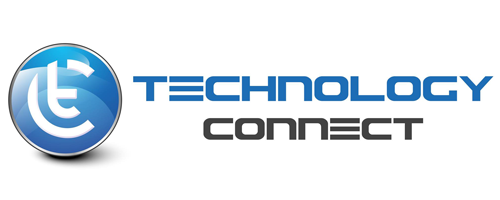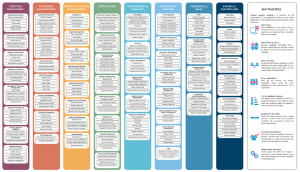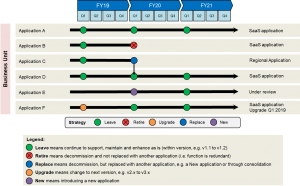

Aligning Digital Transformation and Applications Road Map
By Tom Dissing
A 5-step approach to help companies accelerate and optimise their digital transformation journey and application investments
Australian organisations believe they have 2.2 years to integrate digital initiatives before being disrupted (DXC – Beyond Disruption 2019). Fortunately, almost all (93%) of Australian organisations with more than 1,000 employees have a digital strategy. However, with 1 in 6 business and technology initiatives ending up in failure and with more than 60% of IT budgets being spent on operating and managing applications, it is critical to ensure that application investments are fully aligned to an organisation’s digital transformation strategy. Often, failures are grounded in a disconnect between strategy and execution. It doesn’t have to be this way. Organisations can improve their probability of success significantly by following a playbook of 5 steps to achieve alignment.
What is it and why do we need it?
Digital transformation is an often-used term where boundaries varies a lot. For some organisations it includes a completely new business model, for others it is narrowly focused on digitising a business-critical process. Given the velocity of business and technological change, most organisations are currently undertaking company-wide business transformation programs to remain competitive.
As investment funding is limited and needs to be optimised to achieve the fastest time to value, executives are looking to technology executives for guidance on the right software investments. An organisations application road map sets out future plans across their entire software portfolio, e.g. whether the software is new, being retained or scheduled for retirement.
But often a “chicken and egg” type challenge arise between the executive leadership team and IT to determine how best to optimise application investments. On one hand, the business is seeking guidance from IT on the best technology, whilst on the other hand, IT is seeking guidance from the business on the desired transformation outcomes. Everyone agrees that they are “in this together’, but someone needs to take the first step. To break the “deadlock” and ensure alignment, transparency and collaboration on such strategic decisions, it is important to obtain a shared understanding of how applications currently support the business model.
How do we go about it?
Most organisations do not start from scratch, but it is not uncommon that software inventories are held in multiple spreadsheets or is out of date. The inclination of IT people is to launch a project to establish a full inventory of all installed software. Undoubtedly, this is an important piece of the puzzle, but there is an accelerated way to answering the alignment question. Essentially, a 5 steps playbook has emerged to aligning business transformation with the applications road map.
Step 1: Develop a Business Capability Map
The most important thing to initially getting right is the target state business capability model. A business capability model sets out what an organisation does, but now how is does its business. Figure 1 below is an illustration of a Business Capability Reference Model. Each organisation’s business capability model varies according to the market they play in and the products and services they offer. A reference model is a great starting point, if none is available.
Figure 1: Example Business Capability Reference Model
Source: LeanIX
Step 2: Determine Differentiating Capabilities
With an agreed business capability model, the next step is to determine an organisations differentiating capabilities. These are the 3-6 capabilities that enables the organisation to win in the market. Differentiating capabilities are what customers value the most and that competitors cannot easily imitate. Research shows that organisations with capability-led strategies out-perform their competition (PwC |Strategy& – Strategy That Works, 2016). Secondly, as investment funds and resources for digital transformation are limited, it is important to prioritise technology investments to support these capabilities. Differentiating capabilities needs to be agreed within the executive leadership team. This may require a few rounds of robust discussion and is often accelerated with an independent expert facilitator. Once agreed, the capability model becomes the reference map for application investments.
Step 3: Develop an Applications Inventory
The third step is to develop an inventory of applications that support the differentiating capabilities. This inventory needs to be detailed. In addition to standard technical applications information such as software name, vendor, version etc., it also needs to include business ownership, costs and risk profile. Ideally, an application inventory will contain all applications used by the organisation in a configuration management database (CMDB) or equivalent.
Step 4: Map Applications to Business Capabilities
With the target state business capabilities mapped with current state applications, the forth step is to determine the “strategic and technical fit” of the applications. In other words, how well do these applications align with the IT strategy and architecture, and how well do they support the target state capabilities. To answer the “fitness” question, it is important that the IT strategy considers platforms-based or best-of-breed applications strategies. Most organisations seem to be moving to strategic platforms as their applications strategy, e.g. Microsoft Dynamics, Salesforce, SAP, Oracle and ServiceNow. It has several advantages, such as pre-integration across capabilities, including native automation and pre-configurable workflows driving a user and customer experiences, and high total cost of ownership effectiveness from initial implementation to on-going support and maintenance.
Step 5: Develop Applications Road Map
With existing and new applications mapped to the differentiating capabilities underpinning the transformed business, the final and 5th step is to set out how and when to migrate from the existing applications to the new applications architecture. Visually, this can be achieve as illustrated in Figure 2 below:
Figure 2: Applications Road Map
Source: Technology Connect
The digital transformation strategy and applications road map are now aligned. Business and technology stakeholders have a shared understanding of how it all works, including timing of investments and implementation and how they plan to win in the market. Investments in current and new applications can commence with confidence in making the transformation a success.
If interested in our Business Capability Model or Applications Road Map services for your organisation, please contact us on info@technologyconnect.com.au
Tom Dissing is the founder and Managing Director of Technology Connect. He has 15 years of executive management experience in large scale digital transformations and maximising value from emerging and disruptive technology investments. He has advised senior executives in Financial Services (Banking and Insurance), Media & Entertainment, Construction & Engineering, Technology Services and Government (Federal and State) in Australia, New Zealand, Asia and Europe.
Copyright © 2019 Technology Connect. All rights reserved.





